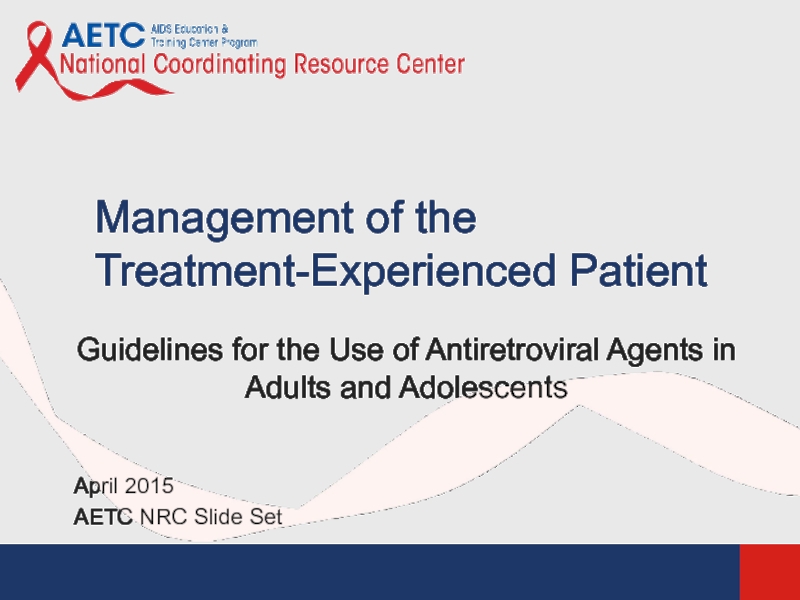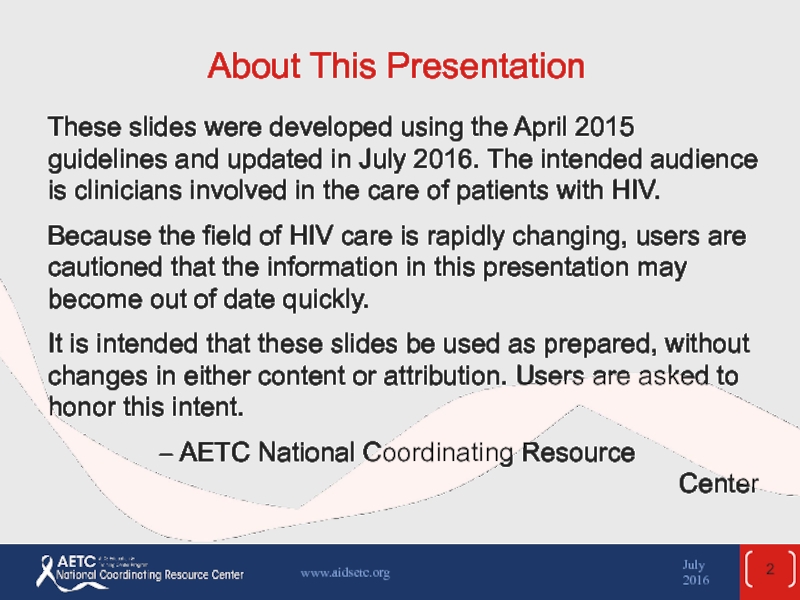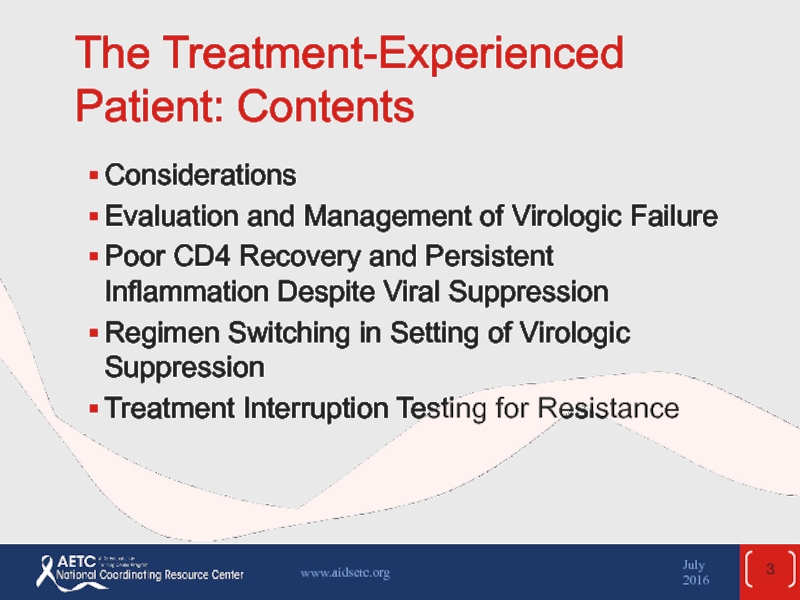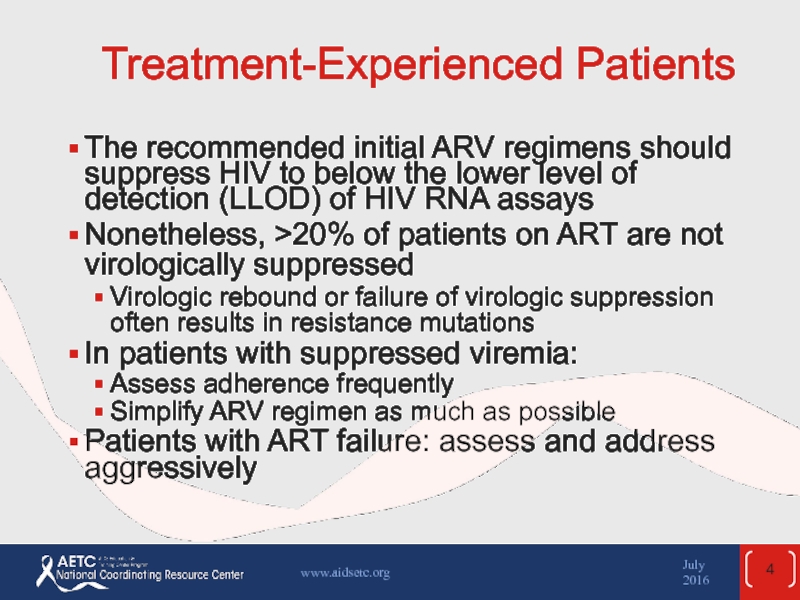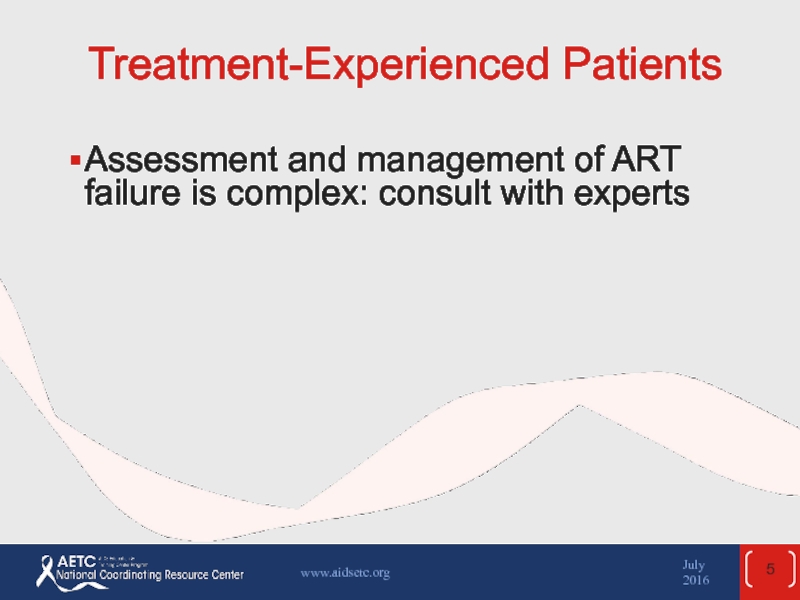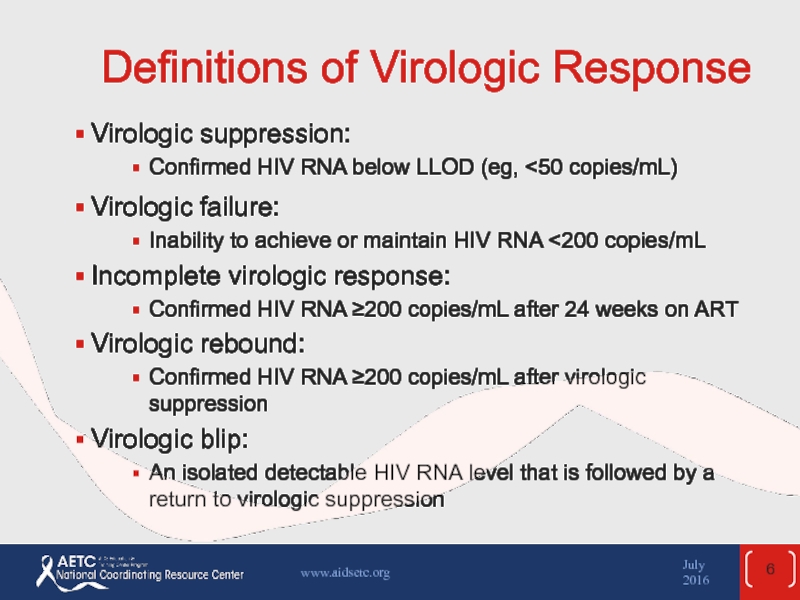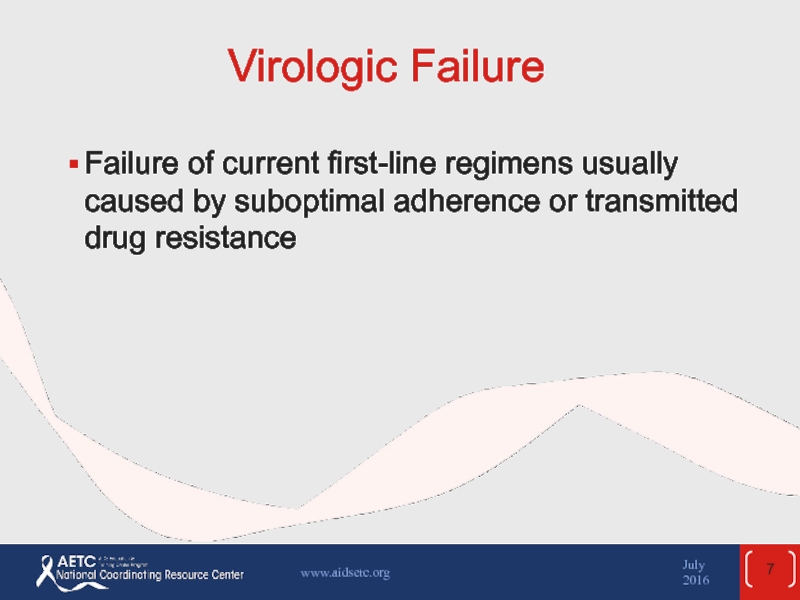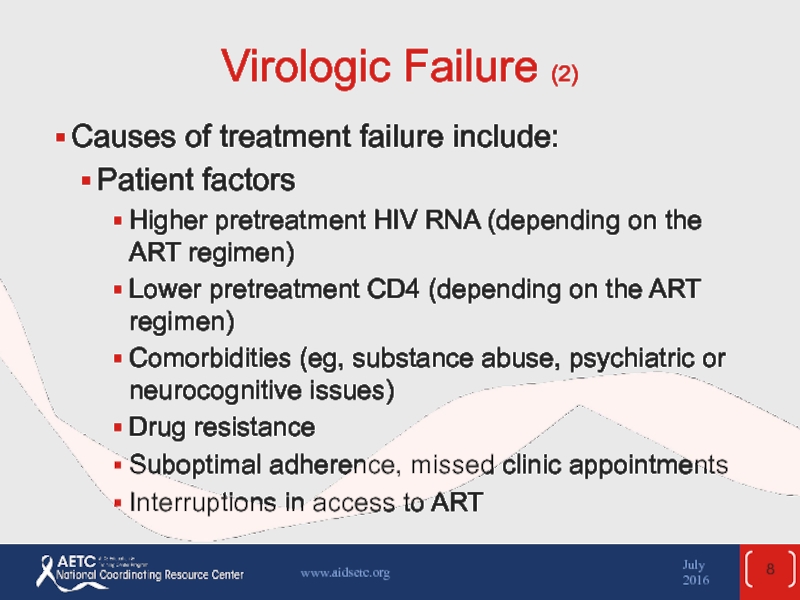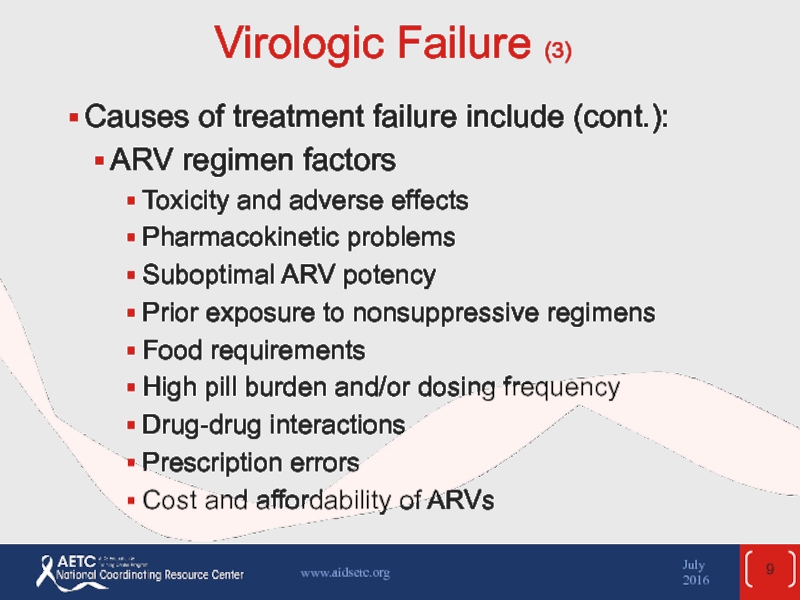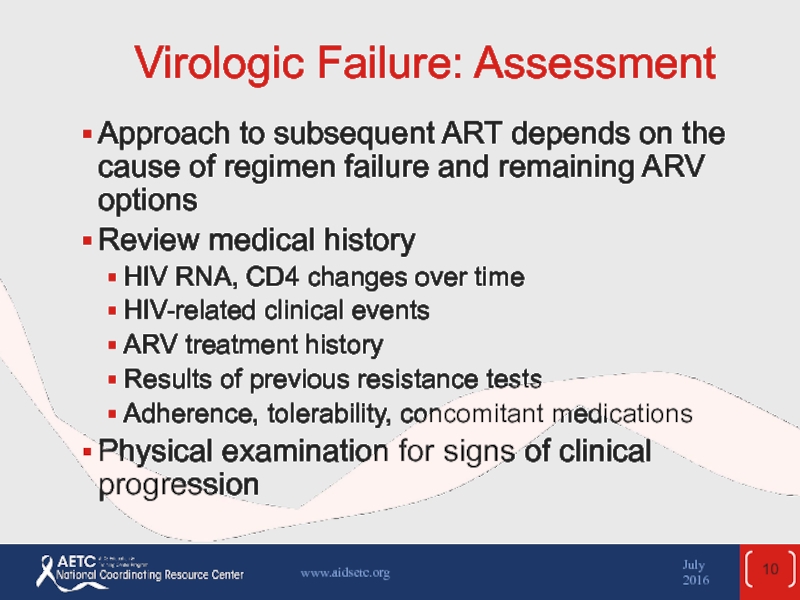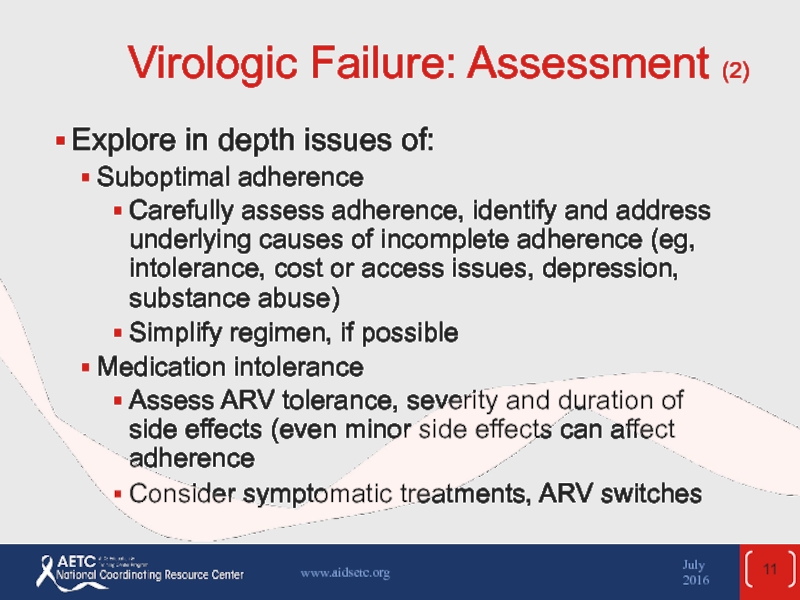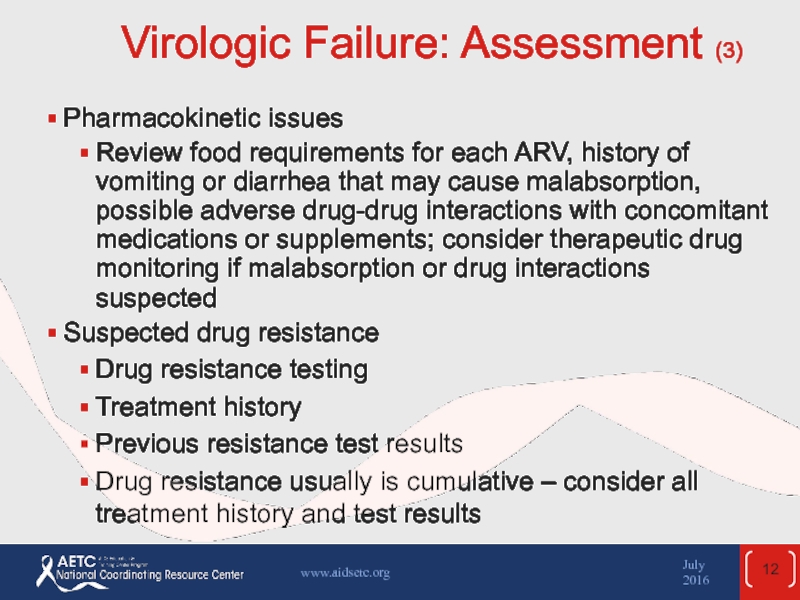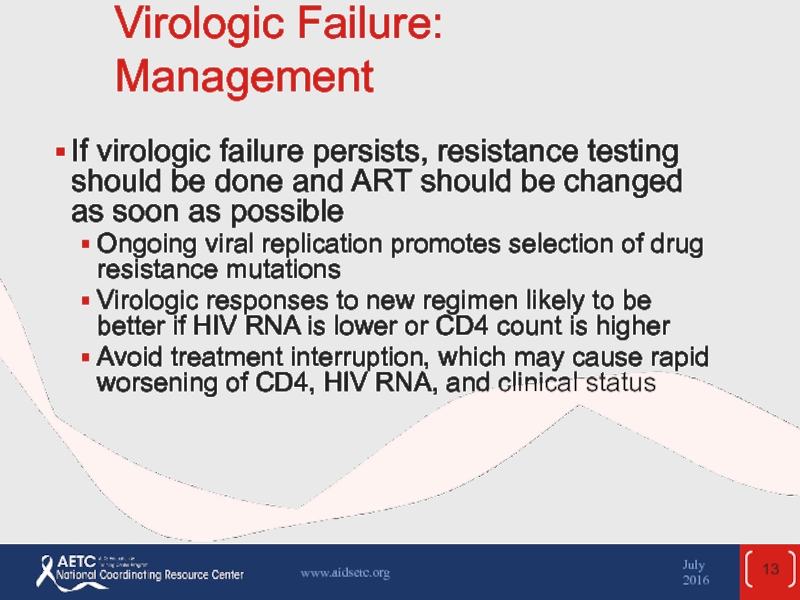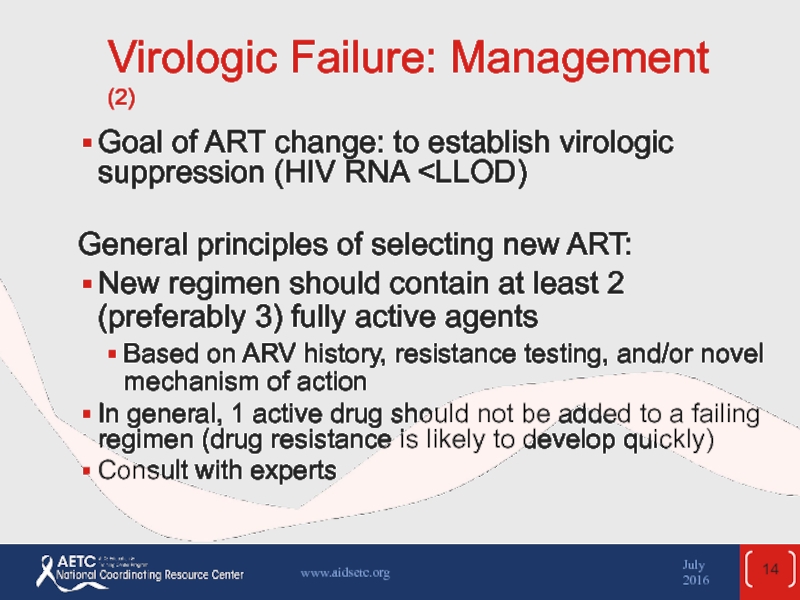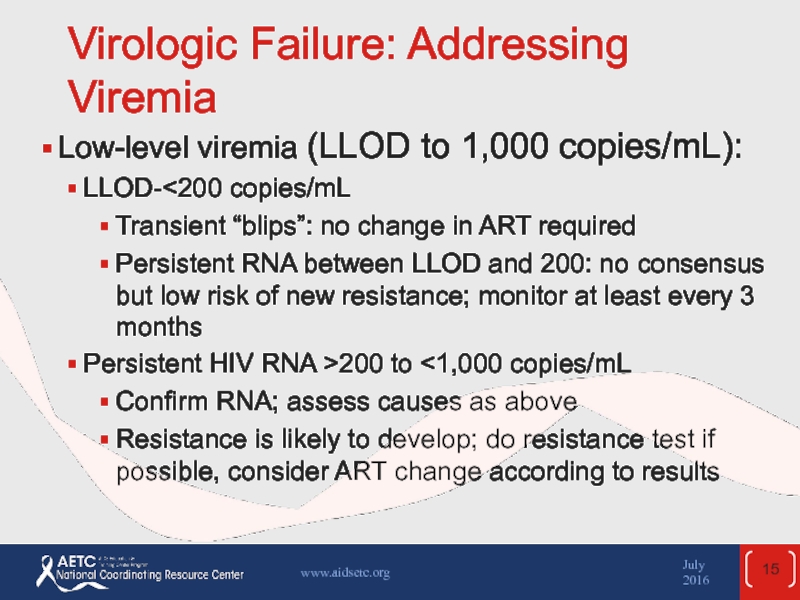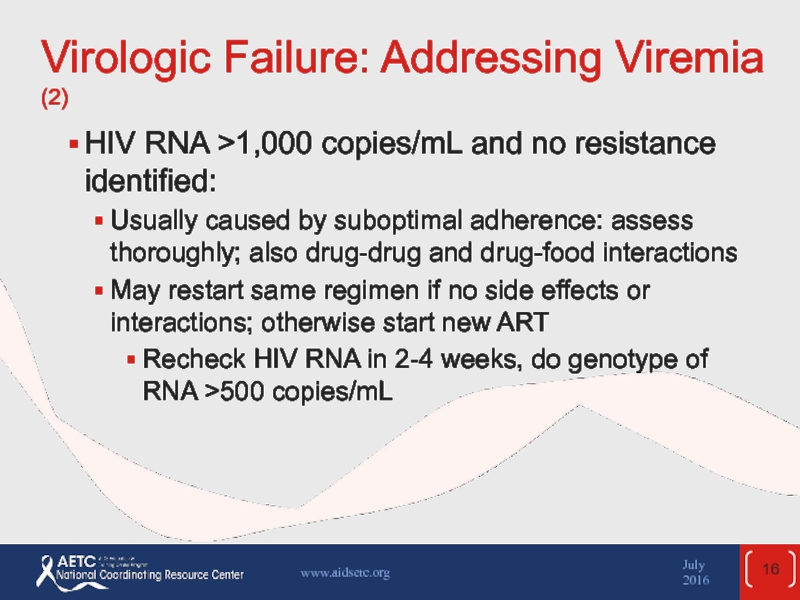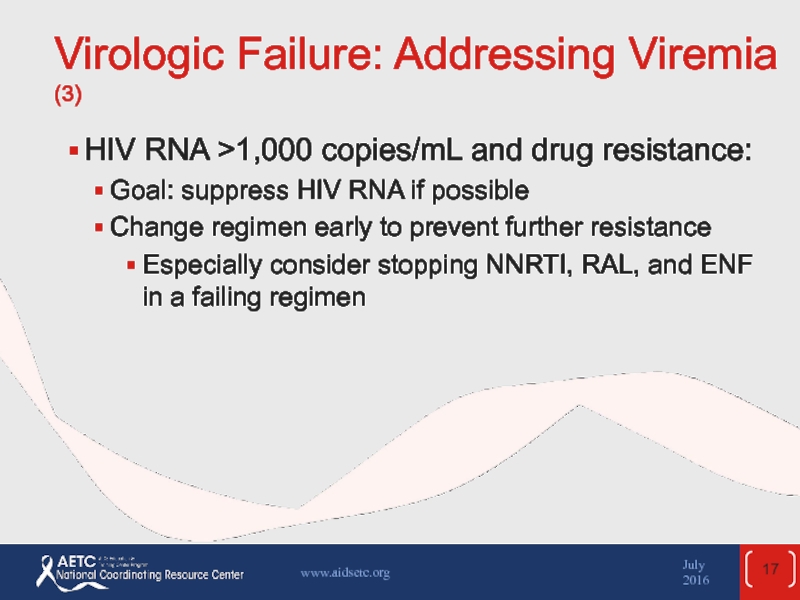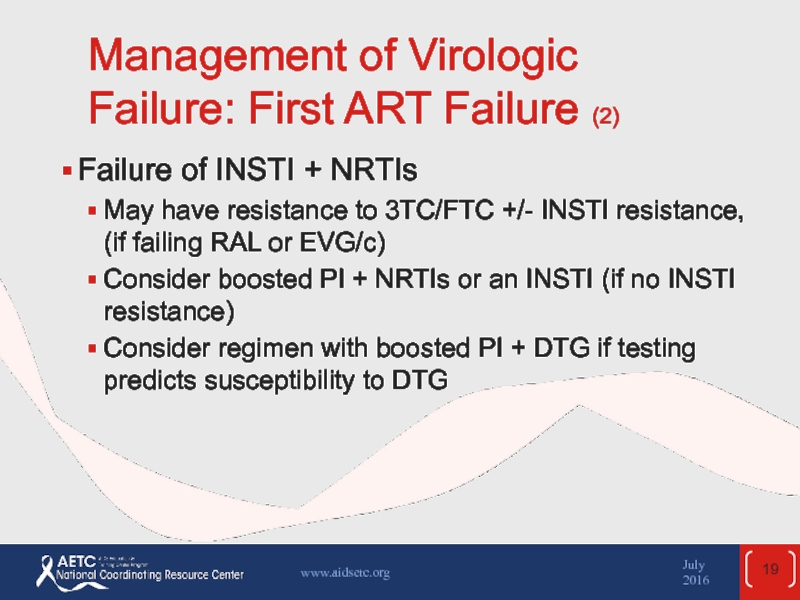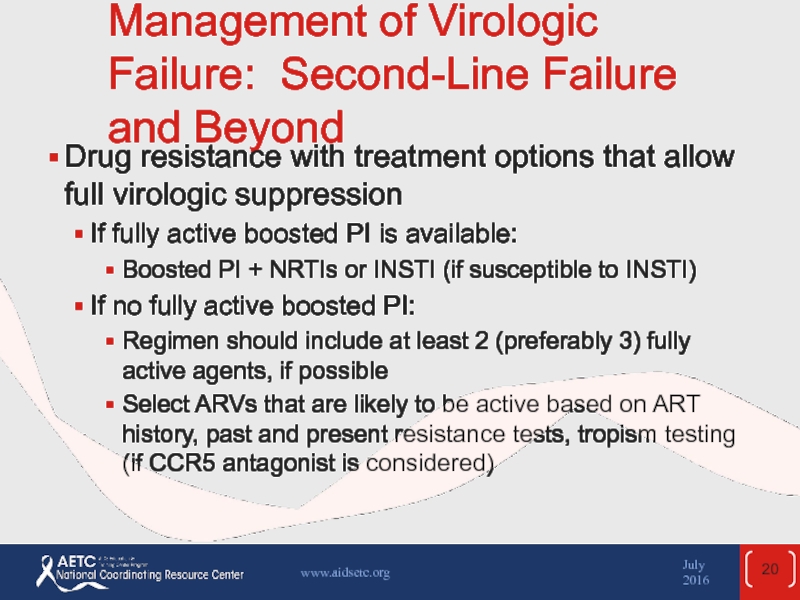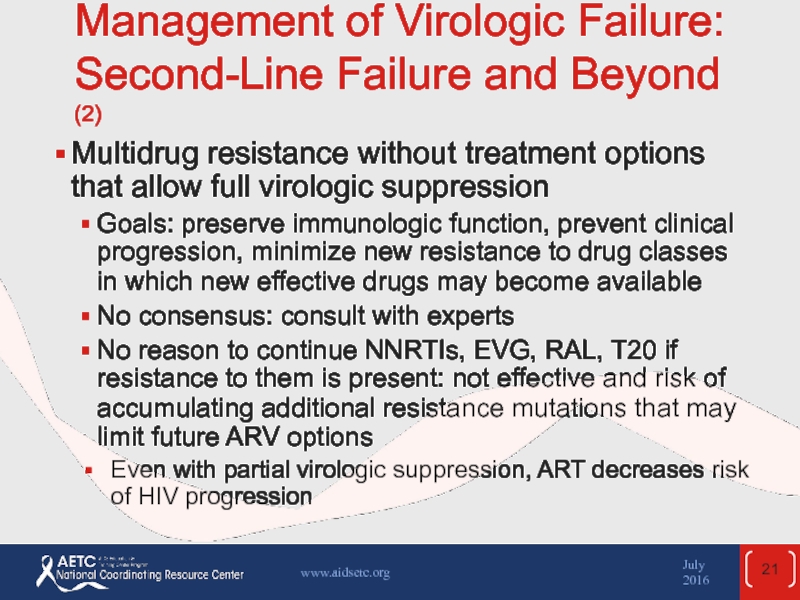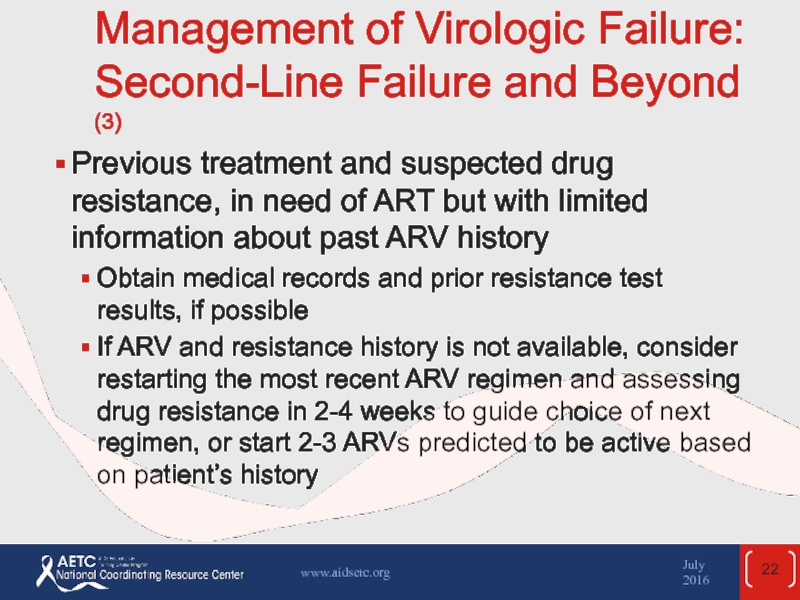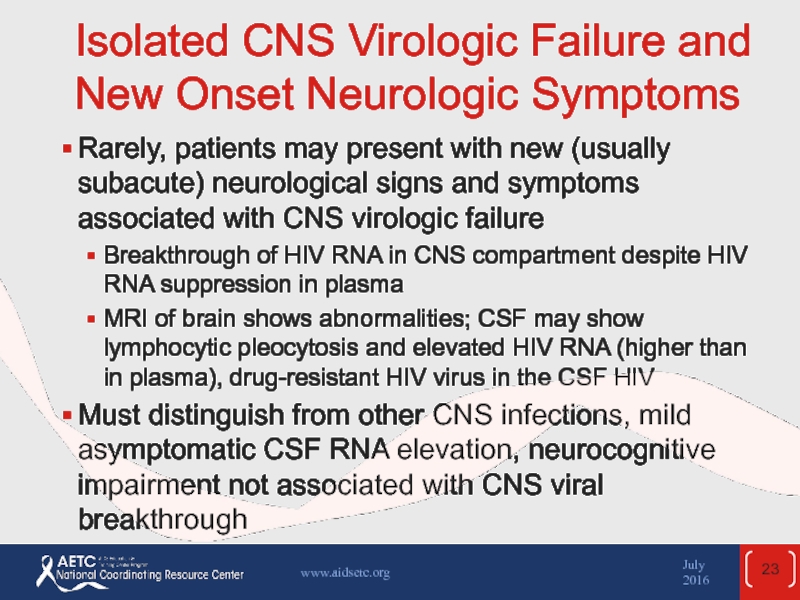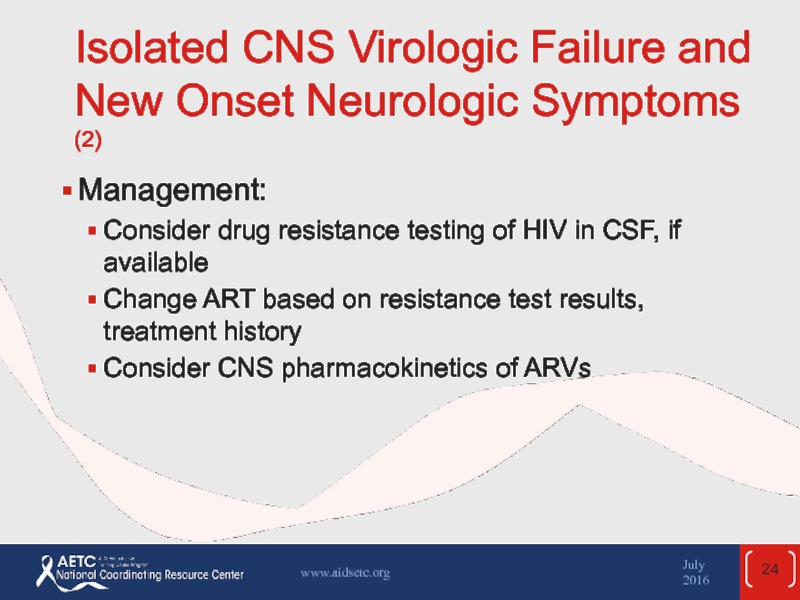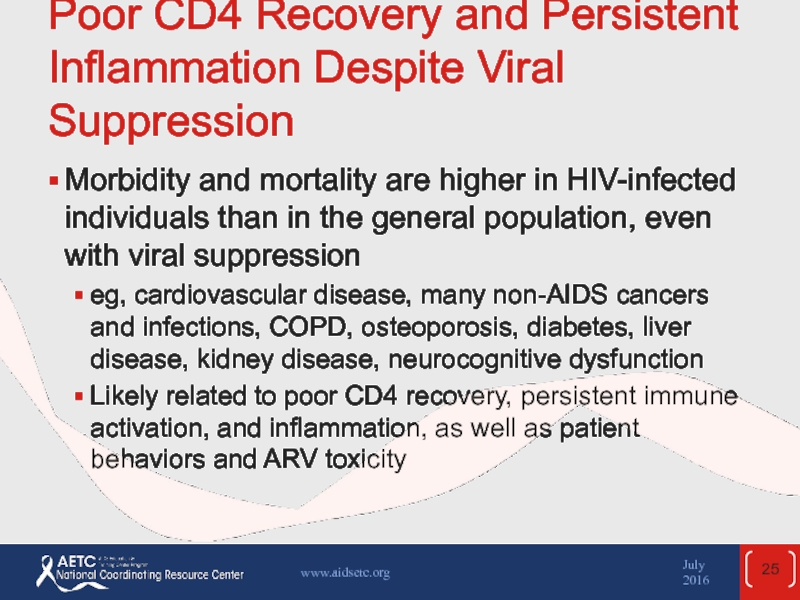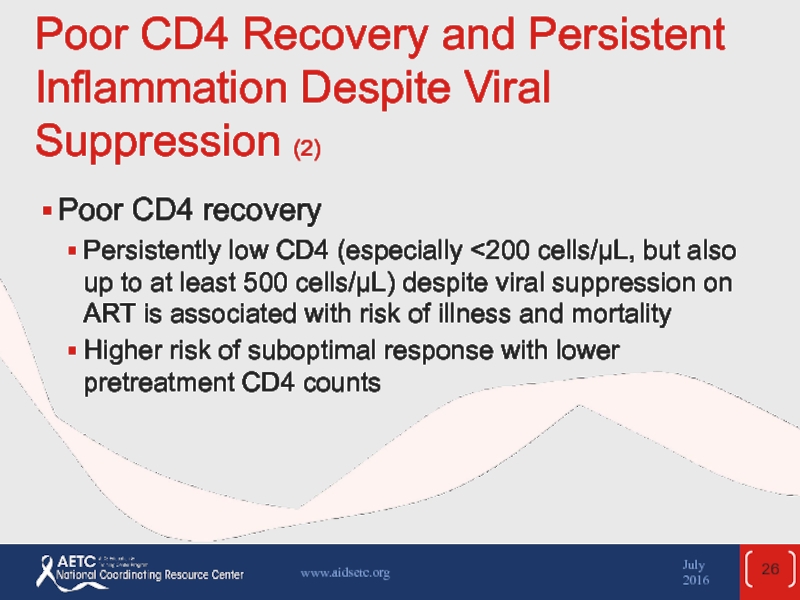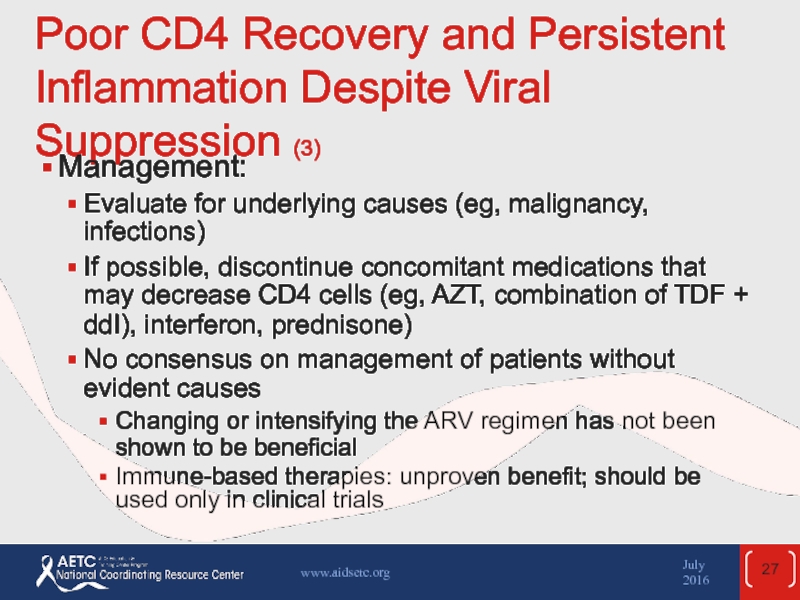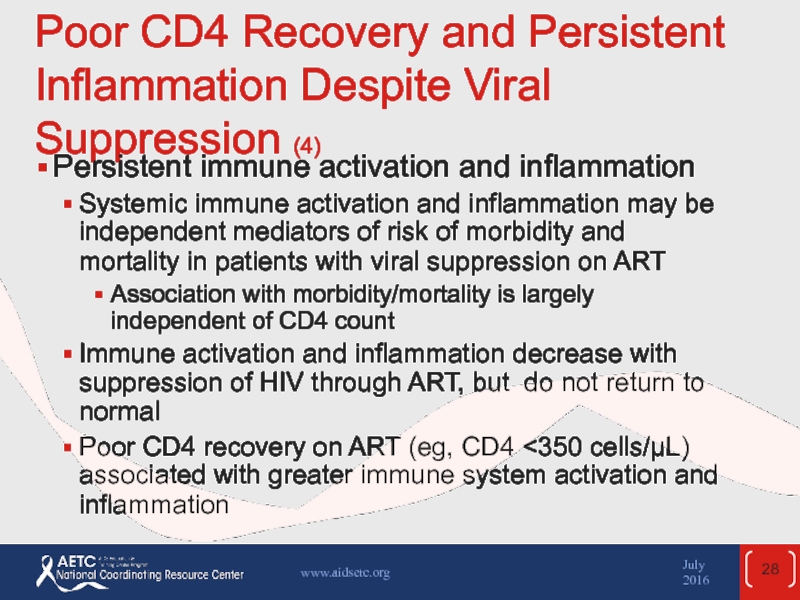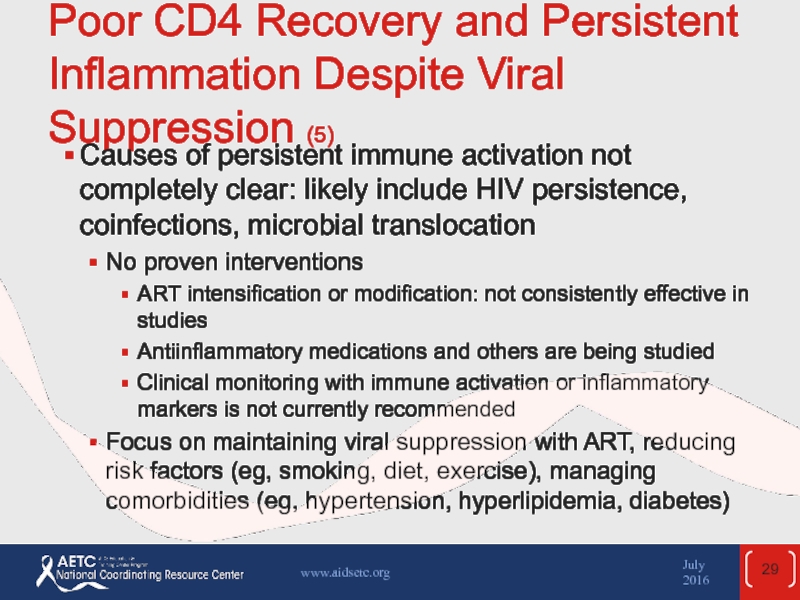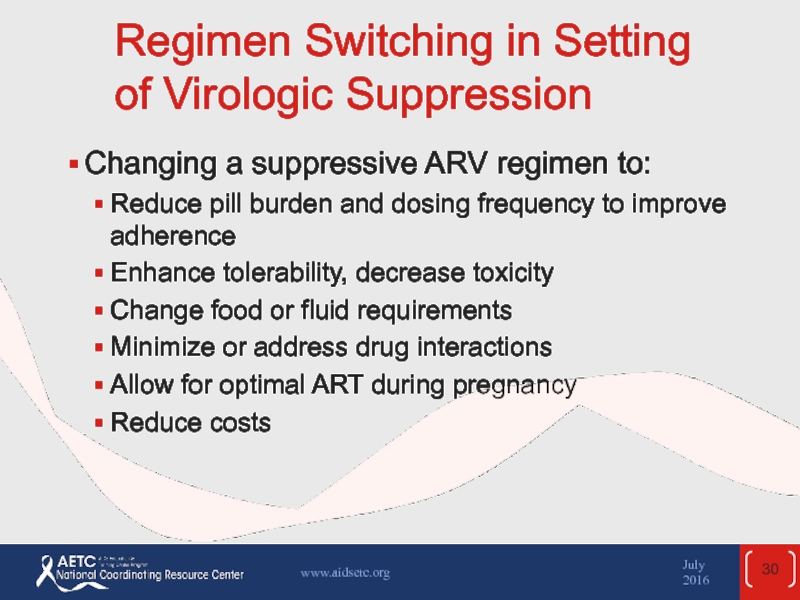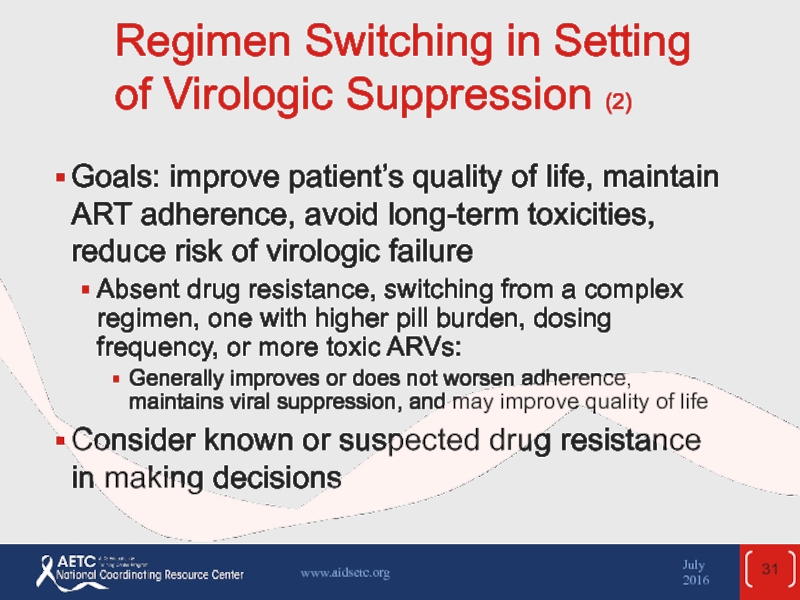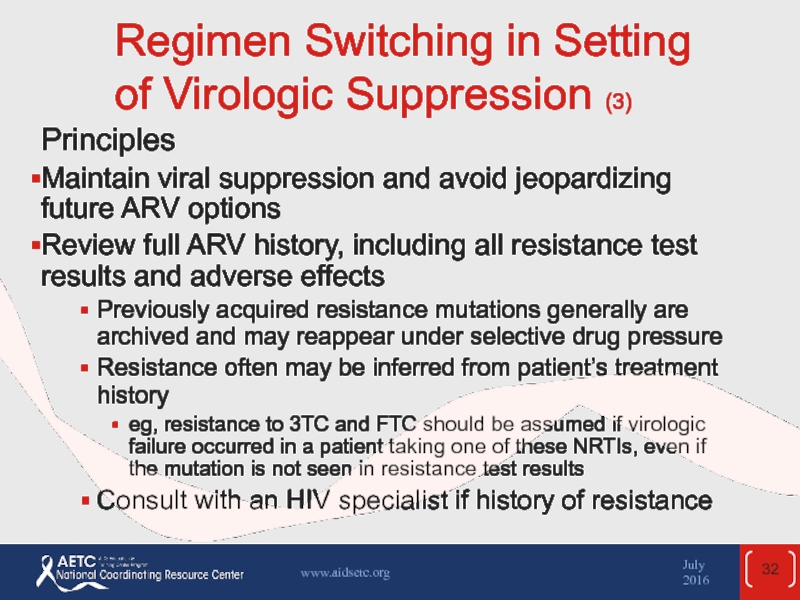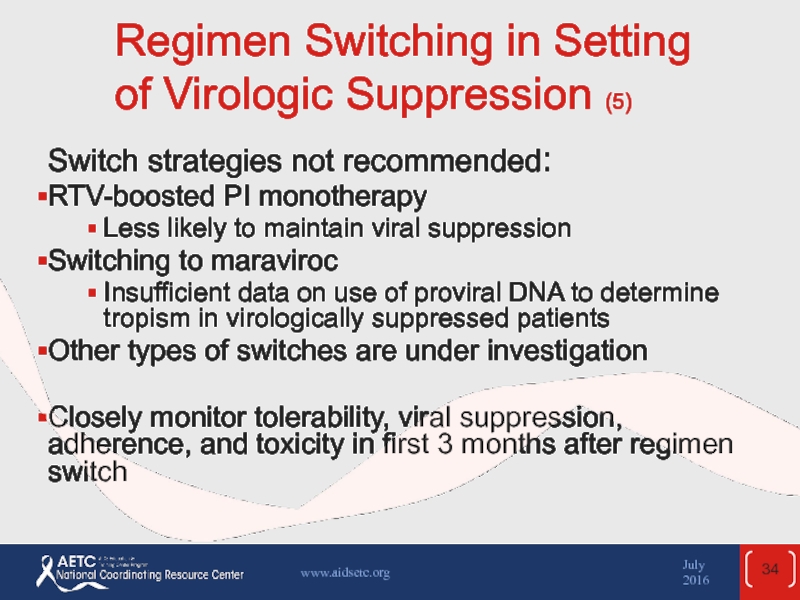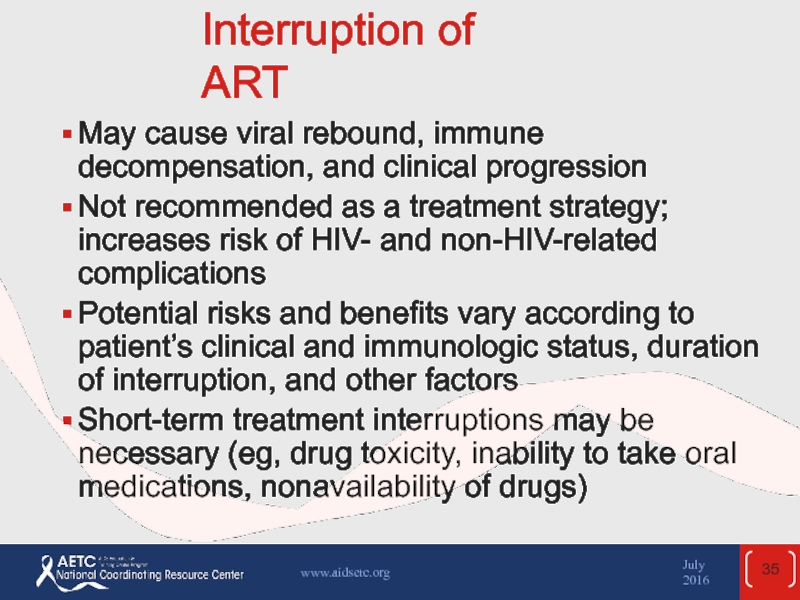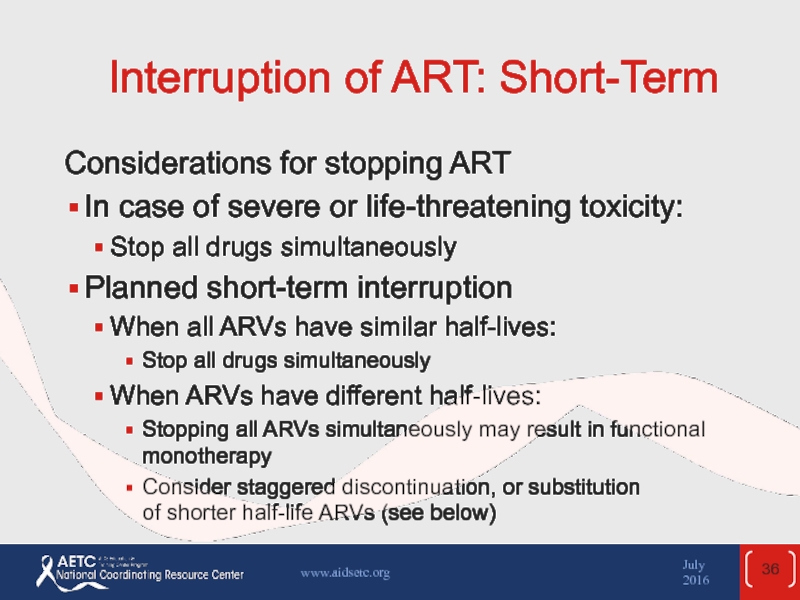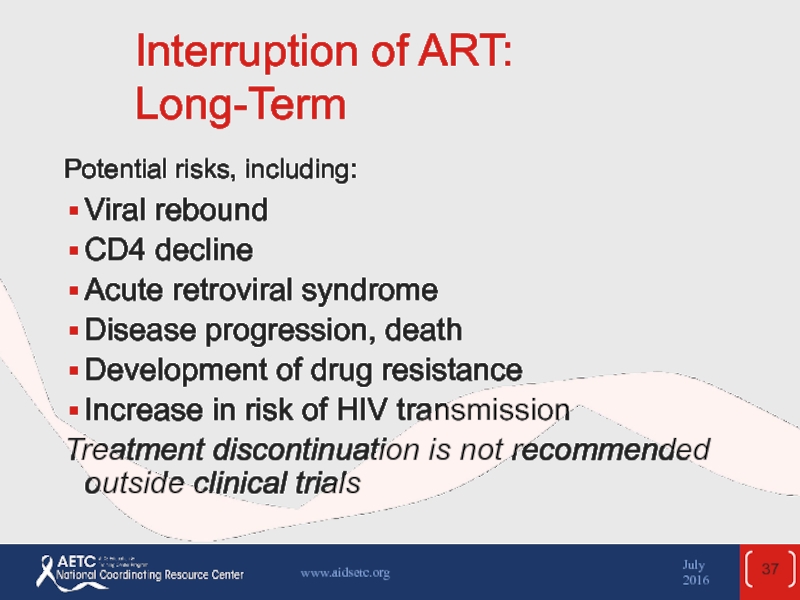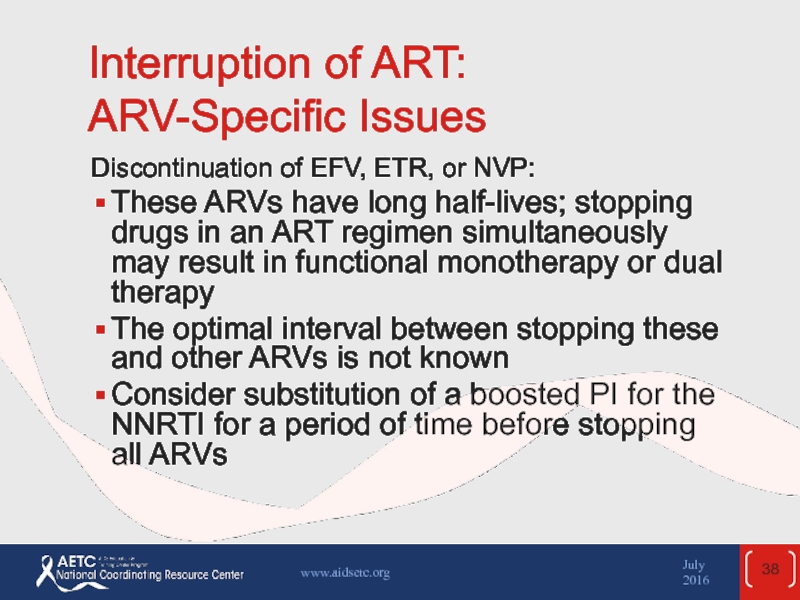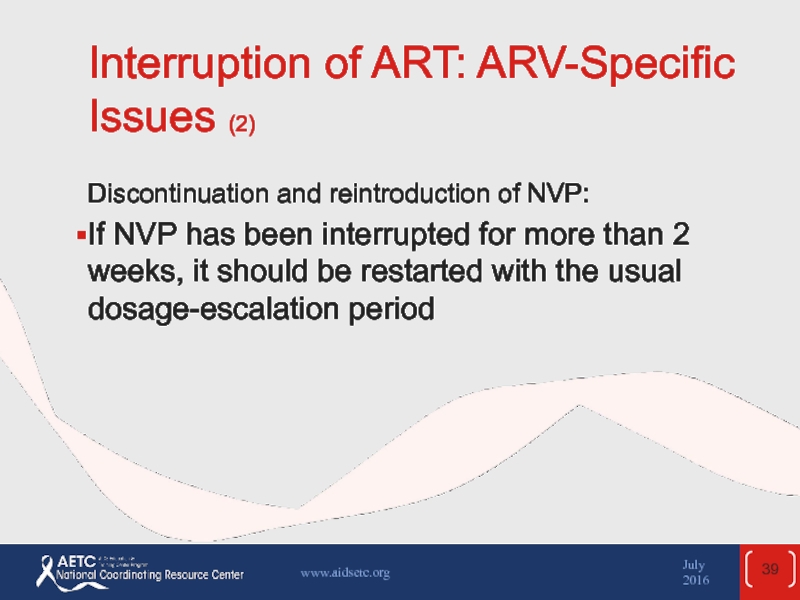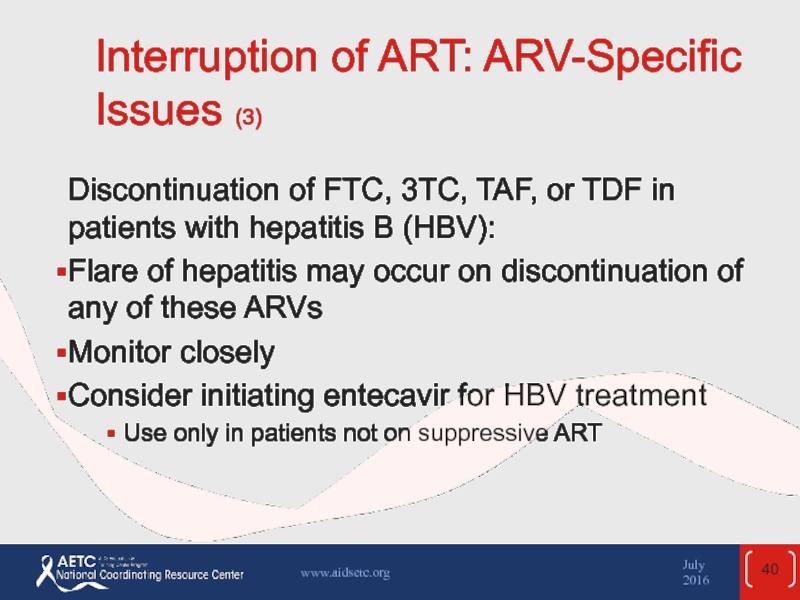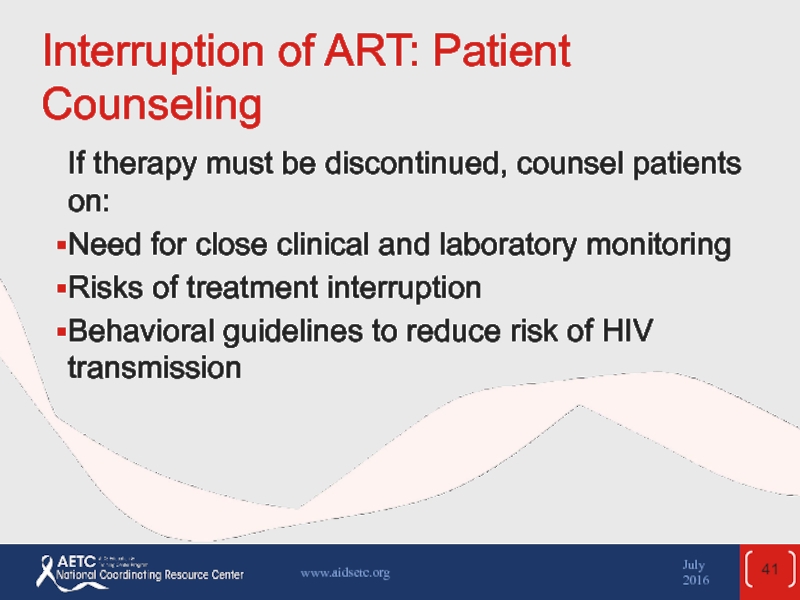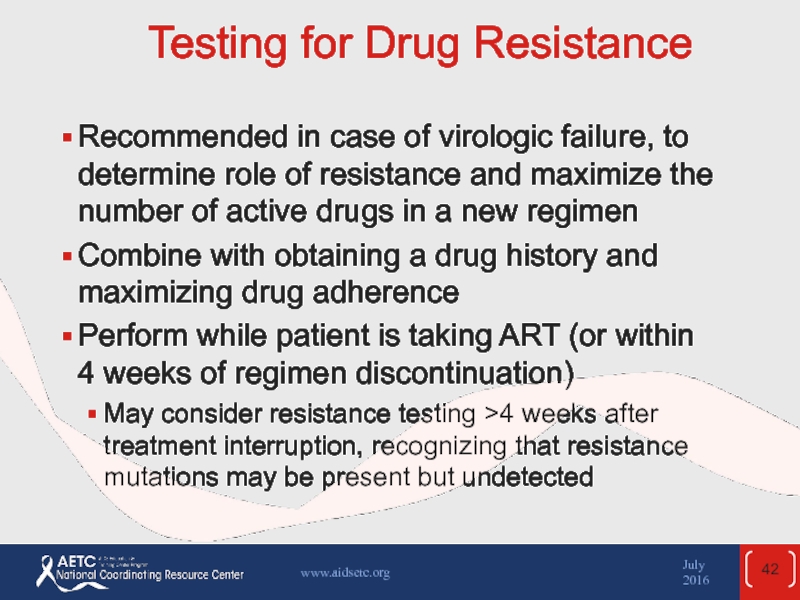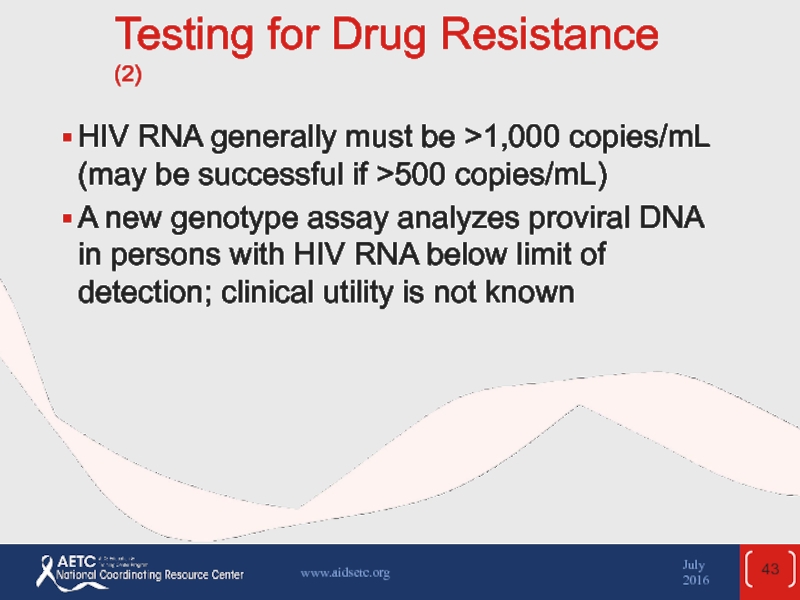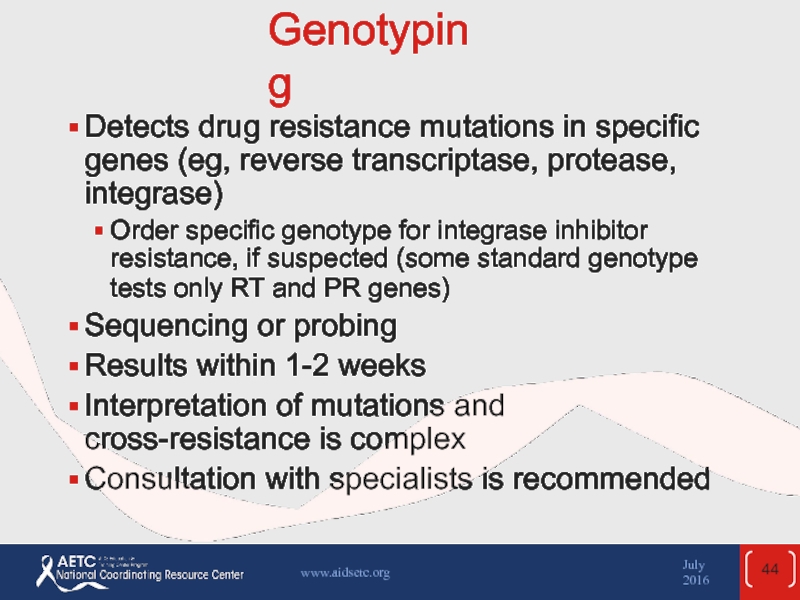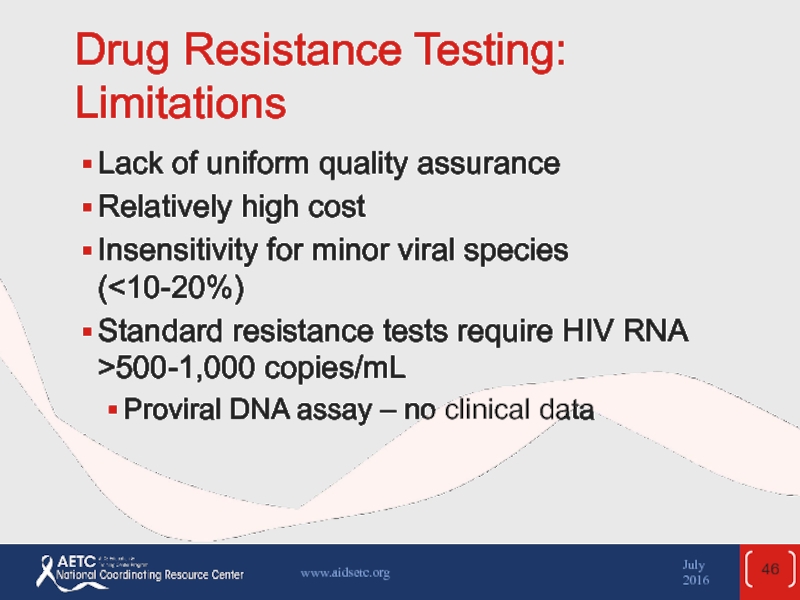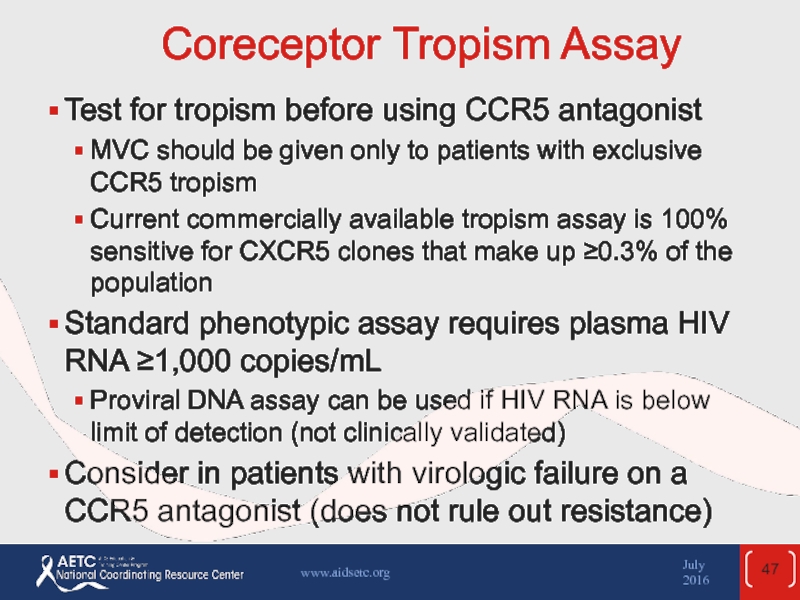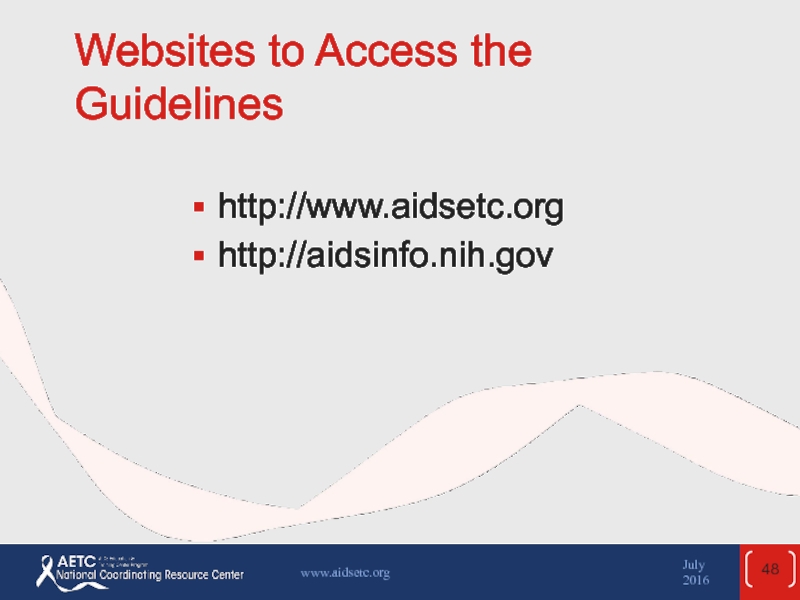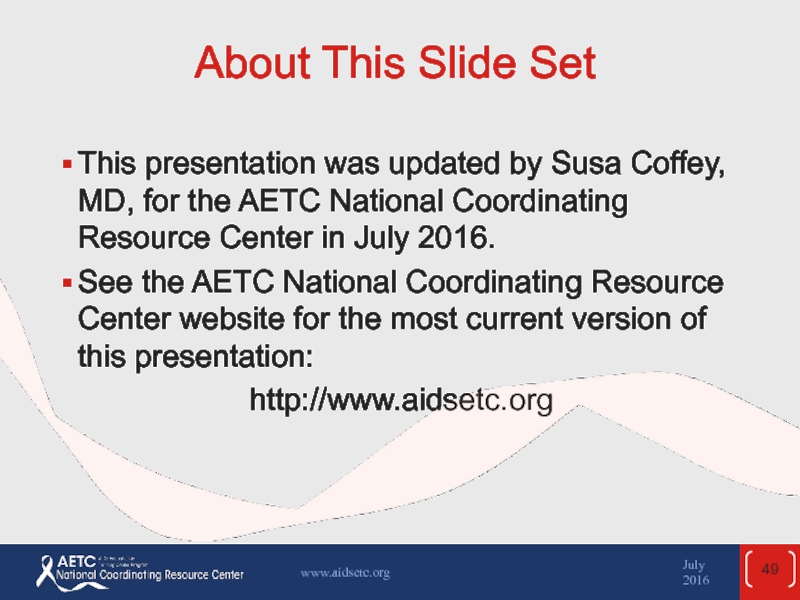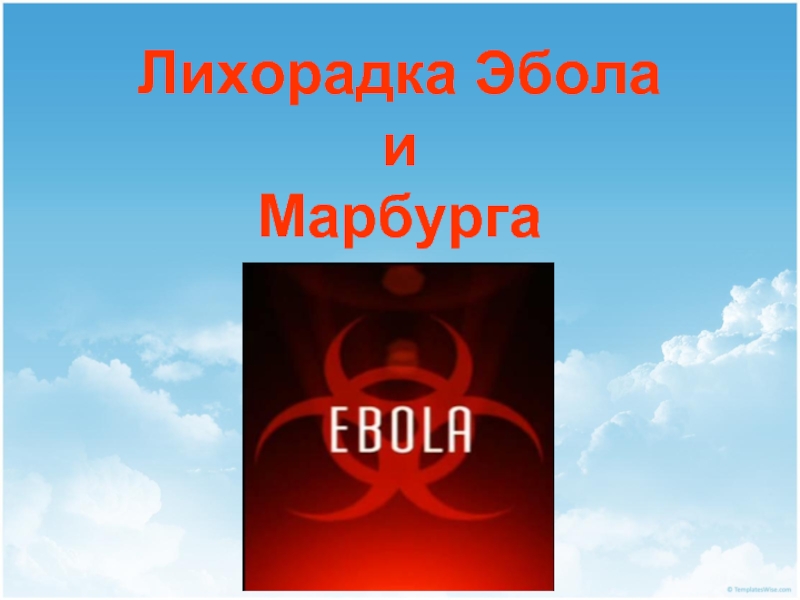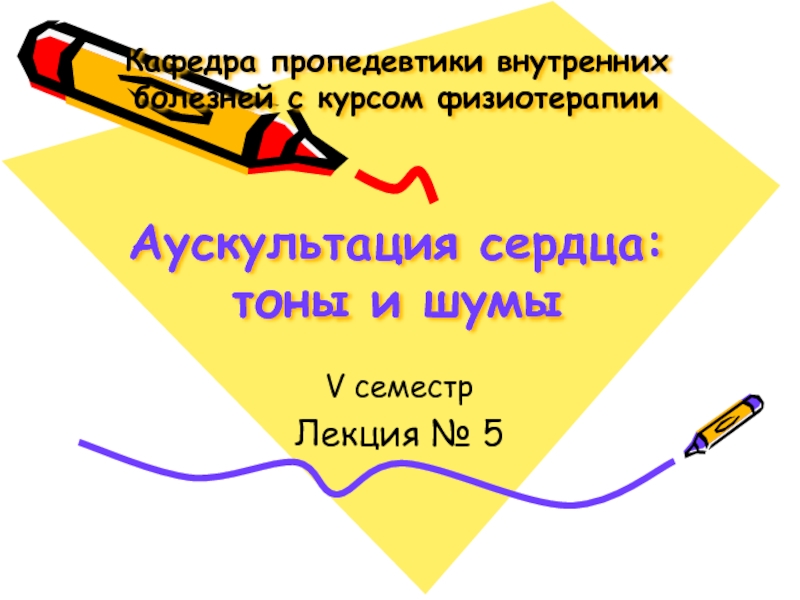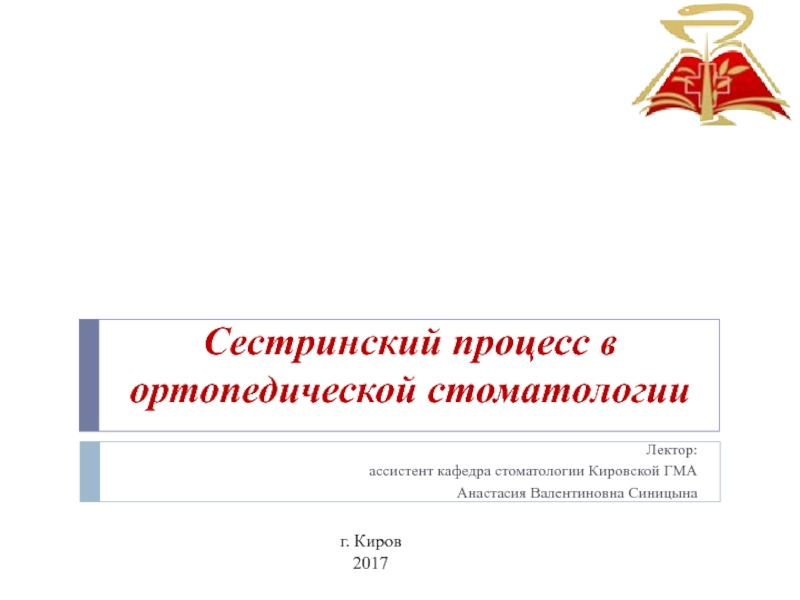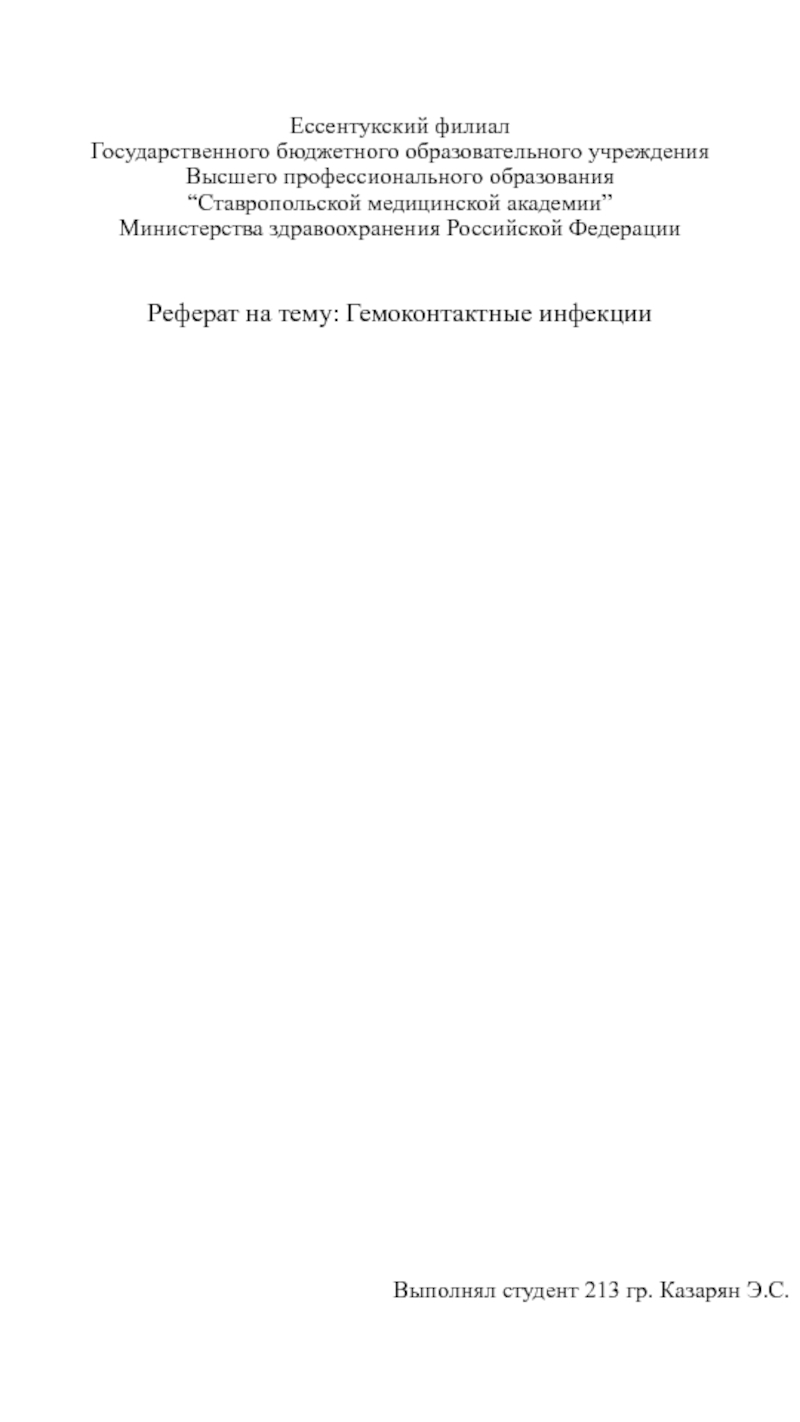- Главная
- Разное
- Дизайн
- Бизнес и предпринимательство
- Аналитика
- Образование
- Развлечения
- Красота и здоровье
- Финансы
- Государство
- Путешествия
- Спорт
- Недвижимость
- Армия
- Графика
- Культурология
- Еда и кулинария
- Лингвистика
- Английский язык
- Астрономия
- Алгебра
- Биология
- География
- Детские презентации
- Информатика
- История
- Литература
- Маркетинг
- Математика
- Медицина
- Менеджмент
- Музыка
- МХК
- Немецкий язык
- ОБЖ
- Обществознание
- Окружающий мир
- Педагогика
- Русский язык
- Технология
- Физика
- Философия
- Химия
- Шаблоны, картинки для презентаций
- Экология
- Экономика
- Юриспруденция
Management of the Treatment-Experienced Patient презентация
Содержание
- 1. Management of the Treatment-Experienced Patient
- 2. July 2016 www.aidsetc.org About This Presentation These
- 3. The Treatment-Experienced Patient: Contents Considerations Evaluation and
- 4. Treatment-Experienced Patients The recommended initial ARV regimens
- 5. Treatment-Experienced Patients Assessment and management of ART
- 6. Definitions of Virologic Response Virologic suppression: Confirmed HIV RNA below LLOD (eg,
- 7. Virologic Failure Failure of current first-line regimens
- 8. Virologic Failure (2) Causes of treatment failure
- 9. Virologic Failure (3) Causes of treatment failure
- 10. Virologic Failure: Assessment Approach to subsequent ART
- 11. Virologic Failure: Assessment (2) Explore in depth
- 12. Virologic Failure: Assessment (3) Pharmacokinetic issues Review
- 13. Virologic Failure: Management If virologic failure
- 14. Virologic Failure: Management (2) Goal of ART change: to establish virologic suppression (HIV RNA
- 15. Virologic Failure: Addressing Viremia Low-level viremia (LLOD to 1,000 copies/mL): LLOD-200 to
- 16. Virologic Failure: Addressing Viremia (2) HIV RNA
- 17. Virologic Failure: Addressing Viremia (3) HIV RNA
- 18. Management of Virologic Failure: First ART Failure
- 19. Management of Virologic Failure: First ART Failure
- 20. Management of Virologic Failure: Second-Line Failure and
- 21. Management of Virologic Failure: Second-Line Failure and
- 22. Management of Virologic Failure: Second-Line Failure and
- 23. Isolated CNS Virologic Failure and New Onset
- 24. Isolated CNS Virologic Failure and New Onset
- 25. Poor CD4 Recovery and Persistent Inflammation Despite
- 26. Poor CD4 Recovery and Persistent Inflammation Despite
- 27. Poor CD4 Recovery and Persistent Inflammation Despite
- 28. Poor CD4 Recovery and Persistent Inflammation Despite
- 29. Poor CD4 Recovery and Persistent Inflammation Despite
- 30. Regimen Switching in Setting of Virologic Suppression
- 31. Regimen Switching in Setting of Virologic Suppression
- 32. Regimen Switching in Setting of Virologic Suppression
- 33. Regimen Switching in Setting of Virologic Suppression
- 34. Regimen Switching in Setting of Virologic Suppression
- 35. Interruption of ART May cause viral rebound,
- 36. Interruption of ART: Short-Term Considerations for
- 37. Interruption of ART: Long-Term Potential risks, including:
- 38. Interruption of ART: ARV-Specific Issues Discontinuation of
- 39. Interruption of ART: ARV-Specific Issues (2) Discontinuation
- 40. Interruption of ART: ARV-Specific Issues (3) Discontinuation
- 41. Interruption of ART: Patient Counseling If therapy
- 42. Testing for Drug Resistance Recommended in case
- 43. Testing for Drug Resistance (2) HIV RNA
- 44. Genotyping Detects drug resistance mutations in specific
- 45. Phenotyping Measures the ability of viruses to
- 46. Drug Resistance Testing: Limitations Lack of uniform
- 47. Coreceptor Tropism Assay Test for tropism before
- 48. Websites to Access the Guidelines July 2016 www.aidsetc.org http://www.aidsetc.org http://aidsinfo.nih.gov
- 49. About This Slide Set This presentation was
Слайд 1Management of the
Treatment-Experienced Patient
Guidelines for the Use of Antiretroviral Agents
April 2015
AETC NRC Slide Set
Слайд 2July 2016
www.aidsetc.org
About This Presentation
These slides were developed using the April 2015
Because the field of HIV care is rapidly changing, users are cautioned that the information in this presentation may become out of date quickly.
It is intended that these slides be used as prepared, without changes in either content or attribution. Users are asked to honor this intent.
– AETC National Coordinating Resource Center
Слайд 3The Treatment-Experienced Patient: Contents
Considerations
Evaluation and Management of Virologic Failure
Poor CD4 Recovery
Regimen Switching in Setting of Virologic Suppression
Treatment Interruption Testing for Resistance
July 2016
www.aidsetc.org
Слайд 4Treatment-Experienced Patients
The recommended initial ARV regimens should suppress HIV to below
Nonetheless, >20% of patients on ART are not virologically suppressed
Virologic rebound or failure of virologic suppression often results in resistance mutations
In patients with suppressed viremia:
Assess adherence frequently
Simplify ARV regimen as much as possible
Patients with ART failure: assess and address aggressively
July 2016
www.aidsetc.org
Слайд 5Treatment-Experienced Patients
Assessment and management of ART failure is complex: consult with
July 2016
www.aidsetc.org
Слайд 6Definitions of Virologic Response
Virologic suppression:
Confirmed HIV RNA below LLOD (eg,
Virologic failure:
Inability to achieve or maintain HIV RNA <200 copies/mL
Incomplete virologic response:
Confirmed HIV RNA ≥200 copies/mL after 24 weeks on ART
Virologic rebound:
Confirmed HIV RNA ≥200 copies/mL after virologic suppression
Virologic blip:
An isolated detectable HIV RNA level that is followed by a return to virologic suppression
July 2016
www.aidsetc.org
Слайд 7Virologic Failure
Failure of current first-line regimens usually caused by suboptimal adherence
July 2016
www.aidsetc.org
Слайд 8Virologic Failure (2)
Causes of treatment failure include:
Patient factors
Higher pretreatment HIV
Lower pretreatment CD4 (depending on the ART regimen)
Comorbidities (eg, substance abuse, psychiatric or neurocognitive issues)
Drug resistance
Suboptimal adherence, missed clinic appointments
Interruptions in access to ART
July 2016
www.aidsetc.org
Слайд 9Virologic Failure (3)
Causes of treatment failure include (cont.):
ARV regimen factors
Toxicity and
Pharmacokinetic problems
Suboptimal ARV potency
Prior exposure to nonsuppressive regimens
Food requirements
High pill burden and/or dosing frequency
Drug-drug interactions
Prescription errors
Cost and affordability of ARVs
July 2016
www.aidsetc.org
Слайд 10Virologic Failure: Assessment
Approach to subsequent ART depends on the cause of
Review medical history
HIV RNA, CD4 changes over time
HIV-related clinical events
ARV treatment history
Results of previous resistance tests
Adherence, tolerability, concomitant medications
Physical examination for signs of clinical progression
July 2016
www.aidsetc.org
Слайд 11Virologic Failure: Assessment (2)
Explore in depth issues of:
Suboptimal adherence
Carefully assess
Simplify regimen, if possible
Medication intolerance
Assess ARV tolerance, severity and duration of side effects (even minor side effects can affect adherence
Consider symptomatic treatments, ARV switches
July 2016
www.aidsetc.org
Слайд 12Virologic Failure: Assessment (3)
Pharmacokinetic issues
Review food requirements for each ARV, history
Suspected drug resistance
Drug resistance testing
Treatment history
Previous resistance test results
Drug resistance usually is cumulative – consider all treatment history and test results
July 2016
www.aidsetc.org
Слайд 13Virologic Failure: Management
If virologic failure persists, resistance testing should be
Ongoing viral replication promotes selection of drug resistance mutations
Virologic responses to new regimen likely to be better if HIV RNA is lower or CD4 count is higher
Avoid treatment interruption, which may cause rapid worsening of CD4, HIV RNA, and clinical status
July 2016
www.aidsetc.org
Слайд 14Virologic Failure: Management (2)
Goal of ART change: to establish virologic suppression
General principles of selecting new ART:
New regimen should contain at least 2 (preferably 3) fully active agents
Based on ARV history, resistance testing, and/or novel mechanism of action
In general, 1 active drug should not be added to a failing regimen (drug resistance is likely to develop quickly)
Consult with experts
July 2016
www.aidsetc.org
Слайд 15Virologic Failure: Addressing Viremia
Low-level viremia (LLOD to 1,000 copies/mL):
LLOD-
Persistent RNA between LLOD and 200: no consensus but low risk of new resistance; monitor at least every 3 months
Persistent HIV RNA >200 to <1,000 copies/mL
Confirm RNA; assess causes as above
Resistance is likely to develop; do resistance test if possible, consider ART change according to results
July 2016
www.aidsetc.org
Слайд 16Virologic Failure: Addressing Viremia (2)
HIV RNA >1,000 copies/mL and no resistance
Usually caused by suboptimal adherence: assess thoroughly; also drug-drug and drug-food interactions
May restart same regimen if no side effects or interactions; otherwise start new ART
Recheck HIV RNA in 2-4 weeks, do genotype of RNA >500 copies/mL
July 2016
www.aidsetc.org
Слайд 17Virologic Failure: Addressing Viremia (3)
HIV RNA >1,000 copies/mL and drug resistance:
Goal: suppress HIV RNA if possible
Change regimen early to prevent further resistance
Especially consider stopping NNRTI, RAL, and ENF in a failing regimen
July 2016
www.aidsetc.org
Слайд 18Management of Virologic Failure: First ART Failure
Failure of NNRTI + NRTIs
Often
Boosted PI + NRTIs or RAL often effective
Failure of boosted PI + NNRTIs
Most have no resistance or resistance only to 3TC/FTC
Assess adherence and drug interactions; may continue same ART or change (eg, if tolerability issues)
July 2016
www.aidsetc.org
Слайд 19Management of Virologic Failure: First ART Failure (2)
Failure of INSTI +
May have resistance to 3TC/FTC +/- INSTI resistance, (if failing RAL or EVG/c)
Consider boosted PI + NRTIs or an INSTI (if no INSTI resistance)
Consider regimen with boosted PI + DTG if testing predicts susceptibility to DTG
July 2016
www.aidsetc.org
Слайд 20Management of Virologic Failure: Second-Line Failure and Beyond
Drug resistance with treatment
If fully active boosted PI is available:
Boosted PI + NRTIs or INSTI (if susceptible to INSTI)
If no fully active boosted PI:
Regimen should include at least 2 (preferably 3) fully active agents, if possible
Select ARVs that are likely to be active based on ART history, past and present resistance tests, tropism testing (if CCR5 antagonist is considered)
July 2016
www.aidsetc.org
Слайд 21Management of Virologic Failure: Second-Line Failure and Beyond (2)
Multidrug resistance without
Goals: preserve immunologic function, prevent clinical progression, minimize new resistance to drug classes in which new effective drugs may become available
No consensus: consult with experts
No reason to continue NNRTIs, EVG, RAL, T20 if resistance to them is present: not effective and risk of accumulating additional resistance mutations that may limit future ARV options
Even with partial virologic suppression, ART decreases risk of HIV progression
July 2016
www.aidsetc.org
Слайд 22Management of Virologic Failure: Second-Line Failure and Beyond (3)
Previous treatment and
Obtain medical records and prior resistance test results, if possible
If ARV and resistance history is not available, consider restarting the most recent ARV regimen and assessing drug resistance in 2-4 weeks to guide choice of next regimen, or start 2-3 ARVs predicted to be active based on patient’s history
July 2016
www.aidsetc.org
Слайд 23Isolated CNS Virologic Failure and New Onset Neurologic Symptoms
Rarely, patients may
Breakthrough of HIV RNA in CNS compartment despite HIV RNA suppression in plasma
MRI of brain shows abnormalities; CSF may show lymphocytic pleocytosis and elevated HIV RNA (higher than in plasma), drug-resistant HIV virus in the CSF HIV
Must distinguish from other CNS infections, mild asymptomatic CSF RNA elevation, neurocognitive impairment not associated with CNS viral breakthrough
July 2016
www.aidsetc.org
Слайд 24Isolated CNS Virologic Failure and New Onset Neurologic Symptoms (2)
Management:
Consider drug
Change ART based on resistance test results, treatment history
Consider CNS pharmacokinetics of ARVs
July 2016
www.aidsetc.org
Слайд 25Poor CD4 Recovery and Persistent Inflammation Despite Viral Suppression
Morbidity and mortality
eg, cardiovascular disease, many non-AIDS cancers and infections, COPD, osteoporosis, diabetes, liver disease, kidney disease, neurocognitive dysfunction
Likely related to poor CD4 recovery, persistent immune activation, and inflammation, as well as patient behaviors and ARV toxicity
July 2016
www.aidsetc.org
Слайд 26Poor CD4 Recovery and Persistent Inflammation Despite Viral Suppression (2)
Poor CD4
Persistently low CD4 (especially <200 cells/µL, but also up to at least 500 cells/µL) despite viral suppression on ART is associated with risk of illness and mortality
Higher risk of suboptimal response with lower pretreatment CD4 counts
July 2016
www.aidsetc.org
Слайд 27Poor CD4 Recovery and Persistent Inflammation Despite Viral Suppression (3)
Management:
Evaluate for
If possible, discontinue concomitant medications that may decrease CD4 cells (eg, AZT, combination of TDF + ddI), interferon, prednisone)
No consensus on management of patients without evident causes
Changing or intensifying the ARV regimen has not been shown to be beneficial
Immune-based therapies: unproven benefit; should be used only in clinical trials
July 2016
www.aidsetc.org
Слайд 28Poor CD4 Recovery and Persistent Inflammation Despite Viral Suppression (4)
Persistent immune
Systemic immune activation and inflammation may be independent mediators of risk of morbidity and mortality in patients with viral suppression on ART
Association with morbidity/mortality is largely independent of CD4 count
Immune activation and inflammation decrease with suppression of HIV through ART, but do not return to normal
Poor CD4 recovery on ART (eg, CD4 <350 cells/µL) associated with greater immune system activation and inflammation
July 2016
www.aidsetc.org
Слайд 29Poor CD4 Recovery and Persistent Inflammation Despite Viral Suppression (5)
Causes of
No proven interventions
ART intensification or modification: not consistently effective in studies
Antiinflammatory medications and others are being studied
Clinical monitoring with immune activation or inflammatory markers is not currently recommended
Focus on maintaining viral suppression with ART, reducing risk factors (eg, smoking, diet, exercise), managing comorbidities (eg, hypertension, hyperlipidemia, diabetes)
July 2016
www.aidsetc.org
Слайд 30Regimen Switching in Setting of Virologic Suppression
Changing a suppressive ARV regimen
Reduce pill burden and dosing frequency to improve adherence
Enhance tolerability, decrease toxicity
Change food or fluid requirements
Minimize or address drug interactions
Allow for optimal ART during pregnancy
Reduce costs
July 2016
www.aidsetc.org
Слайд 31Regimen Switching in Setting of Virologic Suppression (2)
Goals: improve patient’s quality
Absent drug resistance, switching from a complex regimen, one with higher pill burden, dosing frequency, or more toxic ARVs:
Generally improves or does not worsen adherence, maintains viral suppression, and may improve quality of life
Consider known or suspected drug resistance in making decisions
July 2016
www.aidsetc.org
Слайд 32Regimen Switching in Setting of Virologic Suppression (3)
Principles
Maintain viral suppression and
Review full ARV history, including all resistance test results and adverse effects
Previously acquired resistance mutations generally are archived and may reappear under selective drug pressure
Resistance often may be inferred from patient’s treatment history
eg, resistance to 3TC and FTC should be assumed if virologic failure occurred in a patient taking one of these NRTIs, even if the mutation is not seen in resistance test results
Consult with an HIV specialist if history of resistance
July 2016
www.aidsetc.org
Слайд 33Regimen Switching in Setting of Virologic Suppression (4)
Within-class switches:
Usually maintain viral
eg, from EFV to RPV, TDF to TAF, RAL to DTG
Between-class switches:
Usually maintains viral suppression if there is no resistance to the components of the regimen
Avoid this type of switch if there is doubt about the activity of any agents in the regimen
eg, from boosted PI or NNRTI to INSTI
RTV-boosted PI + 3TC or FTC:
Growing evidence that boosted PI + 3TC can maintain viral suppression in ART-naive patients with no baseline resistance and those with sustained viral suppression
May be reasonable if use of TDF, TAF, or ABC is contraindicated
July 2016
www.aidsetc.org
Слайд 34Regimen Switching in Setting of Virologic Suppression (5)
Switch strategies not recommended:
RTV-boosted
Less likely to maintain viral suppression
Switching to maraviroc
Insufficient data on use of proviral DNA to determine tropism in virologically suppressed patients
Other types of switches are under investigation
Closely monitor tolerability, viral suppression, adherence, and toxicity in first 3 months after regimen switch
July 2016
www.aidsetc.org
Слайд 35Interruption of ART
May cause viral rebound, immune decompensation, and clinical progression
Not
Potential risks and benefits vary according to patient’s clinical and immunologic status, duration of interruption, and other factors
Short-term treatment interruptions may be necessary (eg, drug toxicity, inability to take oral medications, nonavailability of drugs)
July 2016
www.aidsetc.org
Слайд 36Interruption of ART: Short-Term
Considerations for stopping ART
In case of severe
Stop all drugs simultaneously
Planned short-term interruption
When all ARVs have similar half-lives:
Stop all drugs simultaneously
When ARVs have different half-lives:
Stopping all ARVs simultaneously may result in functional monotherapy
Consider staggered discontinuation, or substitution of shorter half-life ARVs (see below)
July 2016
www.aidsetc.org
Слайд 37Interruption of ART: Long-Term
Potential risks, including:
Viral rebound
CD4 decline
Acute
Disease progression, death
Development of drug resistance
Increase in risk of HIV transmission
Treatment discontinuation is not recommended outside clinical trials
July 2016
www.aidsetc.org
Слайд 38Interruption of ART: ARV-Specific Issues
Discontinuation of EFV, ETR, or NVP:
These ARVs
The optimal interval between stopping these and other ARVs is not known
Consider substitution of a boosted PI for the NNRTI for a period of time before stopping all ARVs
July 2016
www.aidsetc.org
Слайд 39Interruption of ART: ARV-Specific Issues (2)
Discontinuation and reintroduction of NVP:
If NVP
July 2016
www.aidsetc.org
Слайд 40Interruption of ART: ARV-Specific Issues (3)
Discontinuation of FTC, 3TC, TAF, or
Flare of hepatitis may occur on discontinuation of any of these ARVs
Monitor closely
Consider initiating entecavir for HBV treatment
Use only in patients not on suppressive ART
July 2016
www.aidsetc.org
Слайд 41Interruption of ART: Patient Counseling
If therapy must be discontinued, counsel patients
Need for close clinical and laboratory monitoring
Risks of treatment interruption
Behavioral guidelines to reduce risk of HIV transmission
July 2016
www.aidsetc.org
Слайд 42Testing for Drug Resistance
Recommended in case of virologic failure, to determine
Combine with obtaining a drug history and maximizing drug adherence
Perform while patient is taking ART (or within 4 weeks of regimen discontinuation)
May consider resistance testing >4 weeks after treatment interruption, recognizing that resistance mutations may be present but undetected
July 2016
www.aidsetc.org
Слайд 43Testing for Drug Resistance (2)
HIV RNA generally must be >1,000 copies/mL
A new genotype assay analyzes proviral DNA in persons with HIV RNA below limit of detection; clinical utility is not known
July 2016
www.aidsetc.org
Слайд 44Genotyping
Detects drug resistance mutations in specific genes (eg, reverse transcriptase, protease,
Order specific genotype for integrase inhibitor resistance, if suspected (some standard genotype tests only RT and PR genes)
Sequencing or probing
Results within 1-2 weeks
Interpretation of mutations and cross-resistance is complex
Consultation with specialists is recommended
July 2016
www.aidsetc.org
Слайд 45Phenotyping
Measures the ability of viruses to grow in various concentrations of
Results within 2-3 weeks
More expensive than genotyping
The ratio of the IC50s of the test and reference viruses is reported as the fold increase in IC50, or fold resistance
Interpretation may be complex
Consultation with specialists is recommended
July 2016
www.aidsetc.org
Слайд 46Drug Resistance Testing: Limitations
Lack of uniform quality assurance
Relatively high cost
Insensitivity for
Standard resistance tests require HIV RNA >500-1,000 copies/mL
Proviral DNA assay – no clinical data
July 2016
www.aidsetc.org
Слайд 47Coreceptor Tropism Assay
Test for tropism before using CCR5 antagonist
MVC should be
Current commercially available tropism assay is 100% sensitive for CXCR5 clones that make up ≥0.3% of the population
Standard phenotypic assay requires plasma HIV RNA ≥1,000 copies/mL
Proviral DNA assay can be used if HIV RNA is below limit of detection (not clinically validated)
Consider in patients with virologic failure on a CCR5 antagonist (does not rule out resistance)
July 2016
www.aidsetc.org
Слайд 48Websites to Access the Guidelines
July 2016
www.aidsetc.org
http://www.aidsetc.org
http://aidsinfo.nih.gov
Слайд 49About This Slide Set
This presentation was updated by Susa Coffey, MD,
See the AETC National Coordinating Resource Center website for the most current version of this presentation:
http://www.aidsetc.org
July 2016
www.aidsetc.org
